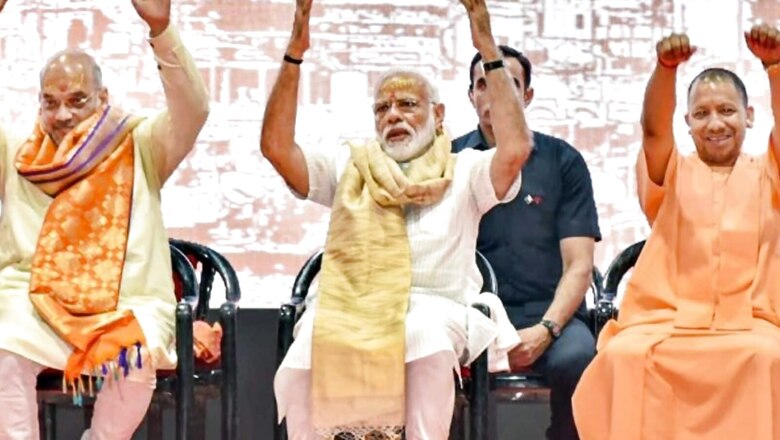
views
A key aspect of the battle to win Uttar Pradesh voters’ hearts and minds is about the collision between the assertion of social identities and the endeavour to sustain and build on a broader Hindu kinship. The tensions inherent in reconciling the two seemingly contradictory aspects, now in play, offer clues to who has the upper hand right now: the BJP/NDA or its closest opponent, the Samajwadi Party (SP) and its allies. At the heart of the battle lies the vast swathe of the Other Backward Classes (OBCs) who form the pivot of the BJP and the SP’s electoral blueprint.
The efforts to woo and possibly co-opt the other social groupings flow from this central strategy because the OBCs, who were not even recognised as a distinct category in the years that the Congress ruled UP, constitute 32.9 per cent of the rural and 36.6 per cent of the urban population, according to data from the Centre’s Social Justice and Empowerment Ministry in 2004-05. This estimate only covers the OBCs living below the poverty line in both villages and towns and cities and not the better-off castes, which are advantageously placed, being the principal beneficiaries of reservation in educational institutions and government jobs as well as the recipients of the largesse handed out by OBC chief ministers.
Of the 39.67 per cent votes secured by the BJP in the last Assembly election in 2017, it is safe to surmise that the OBCs formed the bedrock of its success. The SP polled just 21.86 per cent votes and its ally, the Rashtriya Lok Dal (RLD), 1.78 per cent. This means the SP and its allies have to bridge a 16.03 per cent gap if they have to catch up with the BJP/NDA.
How does the fight pan out in the current scenario? On the plus side, the SP added a former NDA constituent, the Suheldev Bharatiya Samaj Party (SBSP) to its coalition. In 2017, the SBSP won four seats and polled 0.70 per cent votes. In addition, the SP brought the Mahan Dal and the Janvadi Party (Socialist) in its fold. It is still negotiating with the Pragatisheel Samajwadi Party (Lohia), helmed by the SP president Akhilesh Yadav’s estranged uncle, Shivpal Singh Yadav. Shivpal might not have won seats but he damaged the SP in its boroughs in the 2019 Lok Sabha elections.
The BJP retained its partners, the Apna Dal (Sonelal) and Nirbal Indian Shoshit Hamara Aam Dal or NISHAD (the abbreviation fitting neatly into the Nishad caste of fisherfolks the party represents) and acquired many of the smaller entities that were part of the SBSP’s “Bhagiyadari Morcha” but upset with the leader for going unilaterally with the SP. That’s how the alliances stack up for the moment.
What are the ground realities? Is identity-based politics gaining precedence over the Hindutva identity the BJP forged since 2014 and which endured in 2017 and 2019? Some voices from the villages reflect the dilemma of prioritising loyalty to one’s caste over voting as a Hindu but most voters don’t seem to face this quandary.
Caste or Hindutva
Gyan Singh, a former “pradhan” of Safedabad (Barabanki district) classically illustrated the first trend. A Yadav, he said he supervised voting booths for the SP in past elections but was non-committal of his support this time. “The BJP has offered something for all of us. The PM Kisan Samman Nidhi (Rs 6000 to every farmer in three tranches every year) is one of them. Since the pandemic struck, we get free rations twice a month (five kg of food grain and one kg of lentil). The power situation is better than it was in the SP’s time because of the solar power plant in Sandauli,” he said. The plant was inaugurated in 2012 by Akhilesh Yadav when he was the CM but seems to be fully operational only now.
On the Hindutva issue, Singh was clear where his heart lay. “The Ayodhya temple has restored Hindu pride,” he stressed. Ajay Kumar, 24, a small trader at Ataria (Sitapur district), also a Yadav, was just as unequivocal about the Ram temple. “It’s a matter of prestige for us Hindus. This is our Bharat that worships Maryada Purshottam Ram. BJP votes will be consolidated,” he said. An SP voter, asked if he might switch sides this time, Ajay said, “BJP is certainly better placed,” and left it at that.
At the Bahujan Samaj Party (BSP) office on the outskirts of Ram Nagar (Barabanki), Ram Kishore Shukla, the principal of Barabanki’s Rani Laxmibai Memorial Inter-College and a ticket aspirant, was making a concerted play for the Brahmin votes, premised on a belief that Brahmins were “upset” with chief minister Yogi Adityanath’s alleged overt patronage of the Rajputs.
Ashish Mishra, Shukla’s aide, and himself a Brahmin, disabused the belief. “Brahmins and Rajputs are firmly with BJP because of the temple. Few people know that it was the Supreme Court’s ruling that paved the path for its construction. Mostly everyone thinks the Modi government did it. Brahmins will take time to get properly disenchanted with the BJP and we will have to wait,” said Mishra.
The Welfare Package
The raft of sops and freebies, doled out by the UP government with the Centre’s back-up, is ostensibly as much of a vote-catcher as Hindutva. To an extent that people—willingly or a tad grudgingly—excuse price rise. Apart from the Kisan Samman Nidhi and PM Garib Kalyan Anna Yojana, pensions for widows and senior citizens, funds for flood-ravaged areas, from end November until March 2022 (when voting ends), Antodaya card holders will each receive five kg of rice/wheat, one kg lentil, one litre mustard oil, salt and sugar. This month as schools reopened, Rs 1100 was transferred directly to the bank accounts of the underprivileged to purchase school gear for their children.
“The good thing is that the targeted schemes reach the beneficiaries directly without the ‘bichauliya (middleman)’s intervention. We get our entitlements in cash and kind without being cheated. This is a huge improvement over what previous governments did. I will go to the extent of saying that if you take the entitlements and don’t vote for the BJP, you are anti-national,” said Brij Mohan Pal, an OBC farmer of Rithauda village (Kaiserganj Assembly seat).
Ajay Kumar of Ataria cited the case of the PM Awaas Yojana to make a point about the benefit of direct cash transfer. “In my ‘gram sabha’, 15 people got Rs 1,20,000 to construct two rooms and a toilet. But the middleman contracted to build the homes pocketed half the amount in connivance with the ‘pradhan’. Luckily, I got my money directly. I spent a little more and built a nice house,” he said.
As for price rise, Chandrakumar Pal, the “pradhan” of Sarsauli (Sitapur), said, “Without the free rations, the situation would have been much worse. We would have seen hunger deaths.”
The Ujjwala scheme’s spinoff was hit by the escalating cost of cooking gas cylinders (now priced at Rs 950). Mala Mishra, a home-maker in Kesharipur (Barabanki), said while the better-off families managed to juggle their finances and put money aside for the cylinders, the poorer recipients of Ujjwala switched back to firewood. Similarly, the rise in mustard oil price forced even the well-off in the villages to light candles instead of “diyas” on Diwali, said Mala.
Farmers’ Issues
Agrarian problems had a way of thrusting Hindutva and freebies into the background. Raghoram Chauhan, a retired P&T employee who owns a farm at village Tappe Sipah (Bahraich), singled out the shortage of diammonium phosphate fertilizer, the Centre’s inability to scale down diesel price for farmers and the reluctance to announce a minimum support price as major drawbacks. “State intervention to redress the problems of a farmer like me is the biggest failure of the BJP government. The open market is not receptive to buying our produce. The government enacted three farm laws but why isn’t it bringing a law on MSP?” asked Chauhan.
Farmers were also distressed by the rampaging cattle which can no longer be sold to abattoirs after the anti-cow slaughter law kicked in. “The shelter homes only exist on paper or have been contracted to BJP workers who run them shoddily. The out-of-work animals prey upon our fields and damage the crops unless we maintain nightly vigil. We are not allowed to erect barbed fences. This is our only issue with the government,” said Akhilesh Verma, Tikauli village (Sitapur) “pradhan”.
While Adityanath’s law and order management was almost uniformly endorsed for putting “perennial” trouble-makers in place and curbing communal strife, the question is can agrarian troubles dent the BJP’s chances of a comeback?
Radhika Ramaseshan is a senior journalist. She was the political editor at The Telegraph. The views expressed in this article are those of the author and do not represent the stand of this publication.
Read all the Latest Opinions here



















Comments
0 comment